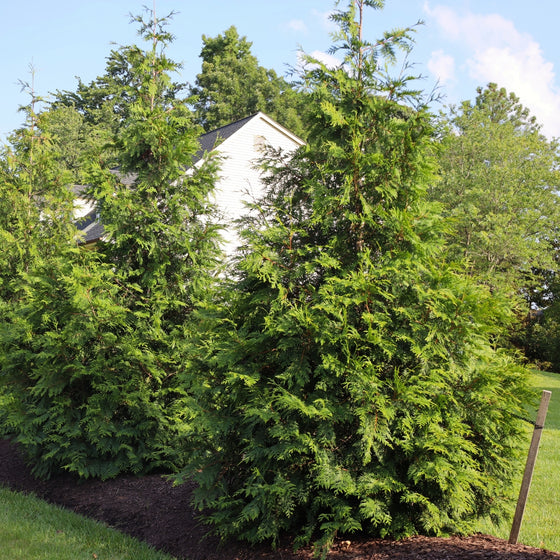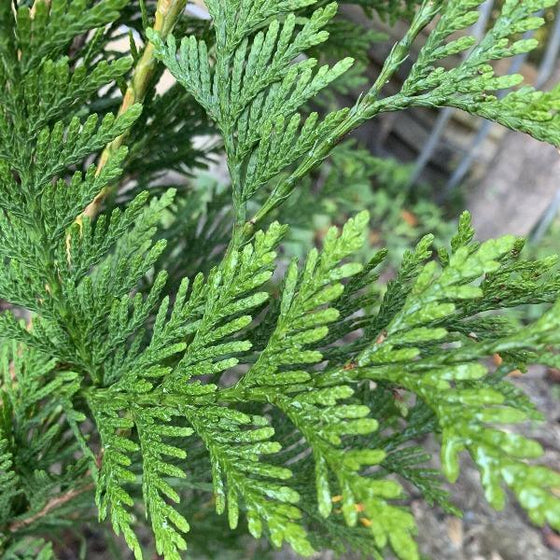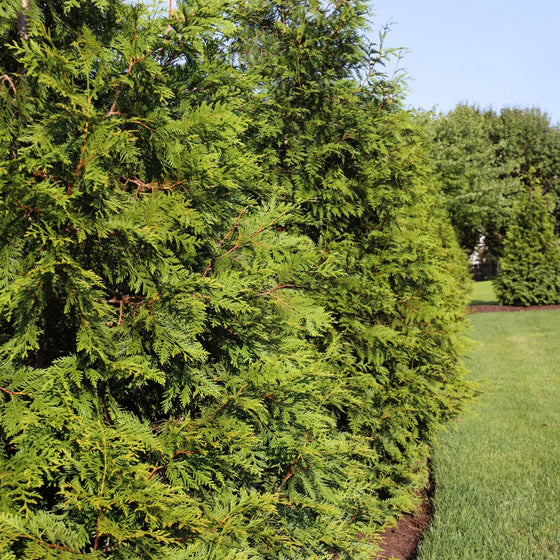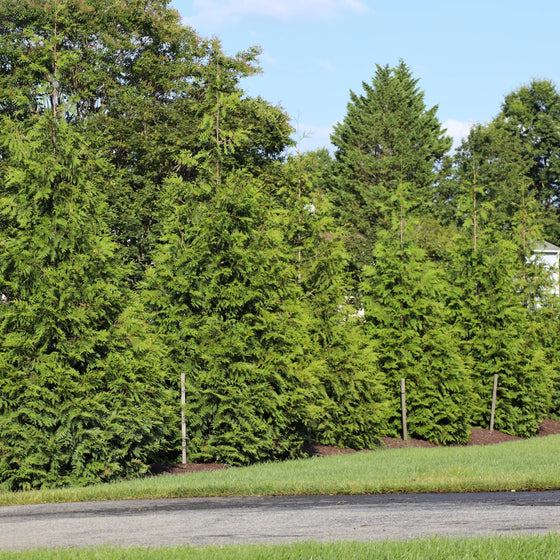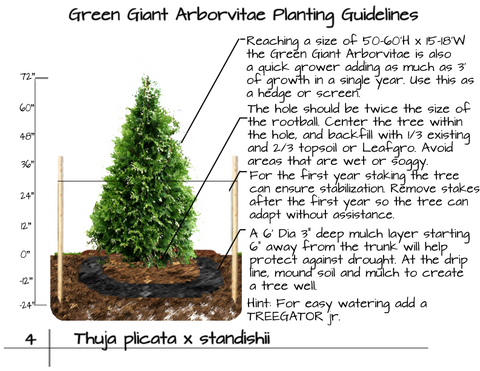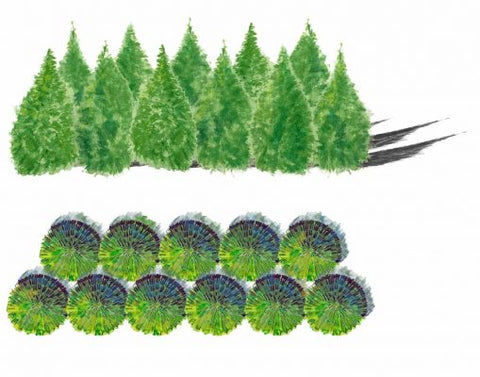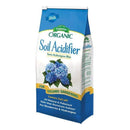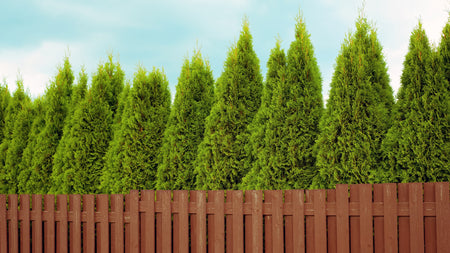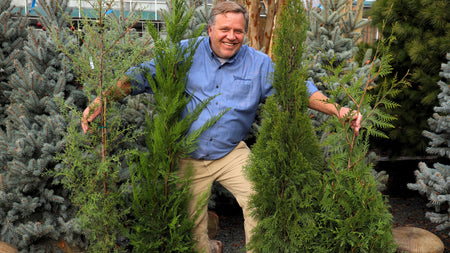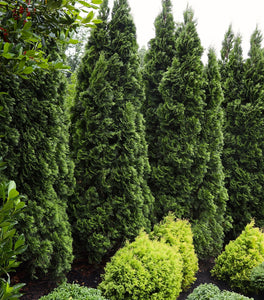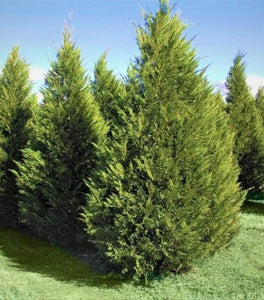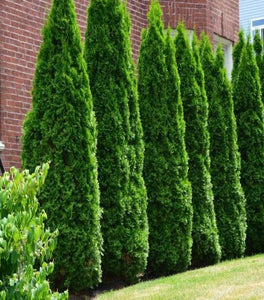
Images Depict Mature Plants
Thuja Green Giant Arborvitae – Fast-Growing Evergreen Privacy Tree
Fastest-growing evergreen for privacy.
The Thuja Green Giant Arborvitae is renowned as the ultimate fast-growing privacy tree, reaching 30–50 feet tall and 12–18 feet wide with a growth rate of 3–5 feet per year. Its naturally dense, rich green foliage forms a lush, living wall that provides year-round coverage and noise reduction. Whether you’re screening a neighboring property or creating a grand windbreak, Green Giant delivers a natural barrier faster than most evergreens.
Low-maintenance and adaptable.
This hardy evergreen thrives in USDA Zones 5–9, tolerating everything from humid summers to cold northern winters. It performs well in full sun to partial shade and adapts to a wide variety of soil types. Once established, Green Giant is drought-tolerant and deer-resistant, giving homeowners peace of mind and eliminating the need for constant maintenance or protection.
Perfect for large-scale landscapes.
Plant Green Giant Arborvitae 5–6 feet apart for a seamless privacy hedge or space them 12–15 feet apart for a row of majestic specimens. Their naturally pyramidal habit and soft, feathery foliage create a striking backdrop for perennial gardens or formal landscapes while also providing a year-round windbreak and sound buffer.
A classic evergreen investment.
Unlike fences that weather over time, a Green Giant living fence only becomes stronger and more beautiful with age. With its disease resistance, fast growth, and long-lived evergreen color, this Thuja variety adds lasting value and curb appeal to your property for decades.
Thuja Green Giant is recognized as an Elite Plant by the US National Arboretum and has been granted the prestigious gold medal by the Pennsylvania Horticultural Society.
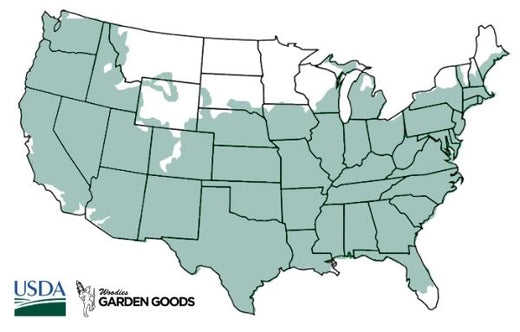
| Hardiness Zone: | 5-9 |
|---|---|
| Mature Height: | 30 to 50 Feet |
| Mature Width: | 12 to 18 Feet |
| Sunlight: | Full sun to partial sun |
| Foliage color: | Dark green |
| Soil Conditions: | Any type of soil |
| Water Requirements: | Water until established |
| Growth Rate: | 3 to 5 Feet per year |
How to Care for Thuja Green Giant Arborvitae
Once you buy a Green Giant Arborvitae, follow the planting and care instructions below for the best outcome:
How do you plant Green Giant Arborvitae for a fast privacy hedge?
To plant Green Giant Arborvitae for a dense, evergreen privacy screen, choose a site in full sun to partial shade with well-drained soil. Dig holes twice as wide as the root ball and space trees 5–6 feet apart on center to allow their natural 12–18 foot spread to overlap for a seamless hedge. Set each tree so the top of the root ball is level with the surrounding soil, backfill halfway, water to settle, then finish backfilling and water again to remove air pockets. Plant in early spring or early fall, when cooler temperatures and consistent moisture help roots establish quickly. Finish with a 2–3 inch mulch layer around each tree—keeping mulch a few inches away from the trunk—to conserve moisture, regulate soil temperature, and reduce weeds. With these steps, your Thuja Green Giant will begin its famous 3–5 feet of annual growth, creating a living fence in just a few seasons.
How often should you water Green Giant Arborvitae after planting?
During the first growing season, give each Green Giant Arborvitae a deep soak once or twice per week, ensuring the water penetrates 8–12 inches into the root zone. Consistent, thorough watering during this establishment phase encourages strong root development and supports the variety’s fast 3–5 foot yearly growth rate. Adjust frequency in hot or dry periods and reduce when rainfall is sufficient. Once established, Green Giant is moderately drought-tolerant and needs supplemental watering only during extended dry spells. A 2–3 inch mulch layer helps retain soil moisture and protects roots from temperature extremes, ensuring the tree’s lush, rich green foliage remains vibrant year-round.
When and how should you fertilize Green Giant Arborvitae trees?
Feed Thuja Green Giant Arborvitae in early spring, just before new growth begins, using a balanced, slow-release evergreen fertilizer. Spread the fertilizer evenly around the tree’s drip line—about a foot or two from the trunk—and water deeply to move nutrients into the soil. This single spring feeding provides the nitrogen and micronutrients needed to sustain the tree’s rapid vertical growth and dense, emerald-green foliage. If your soil is sandy or low in nutrients, you can apply a light second feeding in midsummer, but avoid fertilizing after midsummer so new shoots harden before winter. With this routine, your Green Giant Arborvitae hedge will maintain vigorous growth and the thick, year-round privacy screen homeowners value.

How and when do you prune Green Giant Arborvitae for shape and size?
Green Giant Arborvitae naturally forms a full, pyramidal habit, so it rarely requires heavy pruning. In late winter or early spring, before new growth emerges, inspect each tree and use clean, sharp pruners to remove any dead, damaged, or crossing branches. This improves air circulation and keeps the evergreen healthy and attractive. For a more formal hedge, you can lightly shear or hand-clip the outer growth in late spring or early summer after the first flush of growth. Avoid cutting into old wood, as arborvitae do not regenerate from bare stems. With occasional light trimming, your Thuja Green Giant privacy hedge will remain dense, symmetrical, and vibrant for decades.

